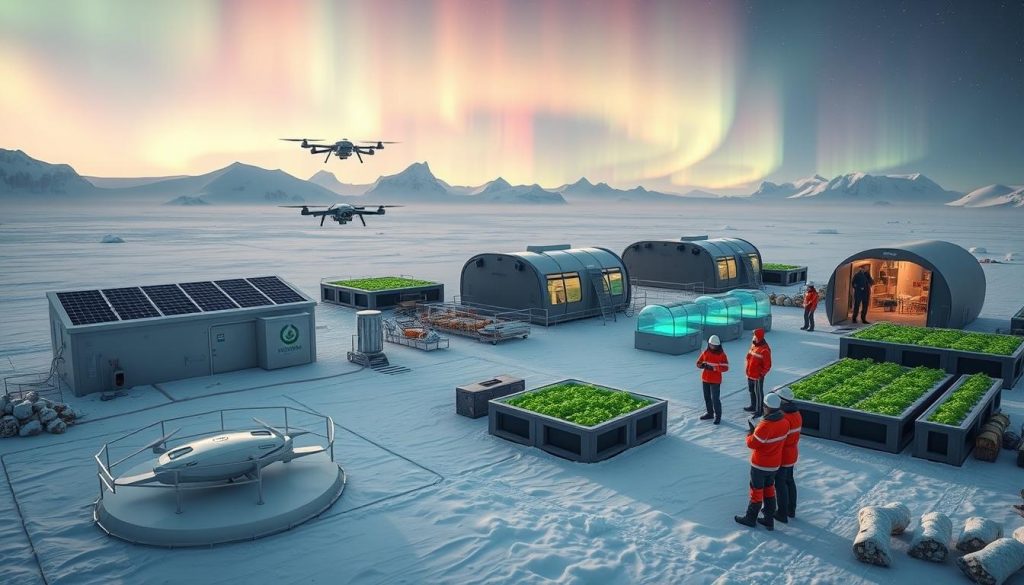As climate change effects grow and more tourists visit, managing waste in Antarctica is getting tougher. This area’s fragile ecosystem needs new, effective, and lasting waste management ideas. More research stations and visitors mean a greater demand for strong waste solutions for the polar areas.
To tackle these issues, it’s crucial to know the special environment there. We must also start using the latest recycling technologies. And adopt practices that fit the harsh conditions of this landscape.
Understanding the Waste Management Challenges in Antarctica
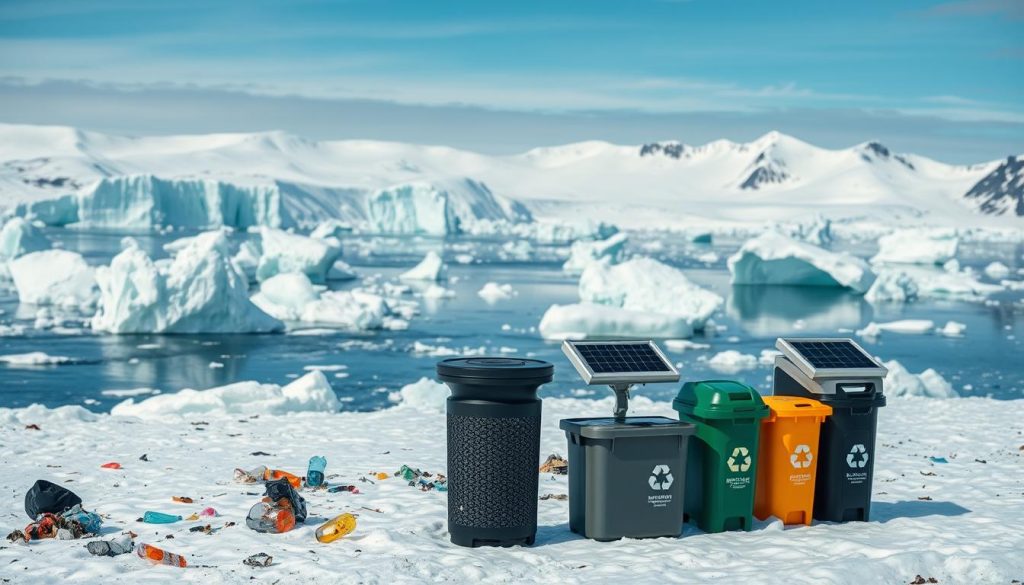
The Antarctic environment has unique waste management challenges. Extreme cold and strong winds make it hard to handle and transport waste. Research stations are far away, which makes it even tougher to move waste off the continent.
Research stations create lots of waste, like food scraps and hazardous substances. It’s important to understand the needs and limits of waste management here. To protect the fragile environment, sustainable waste strategies are a must.
There are strict rules to follow under the Antarctic Treaty System. Adopting smart and responsible waste practices is key. It helps preserve the ecosystem and lessen humans’ impact.
Waste Management Business Ideas in Antarctica
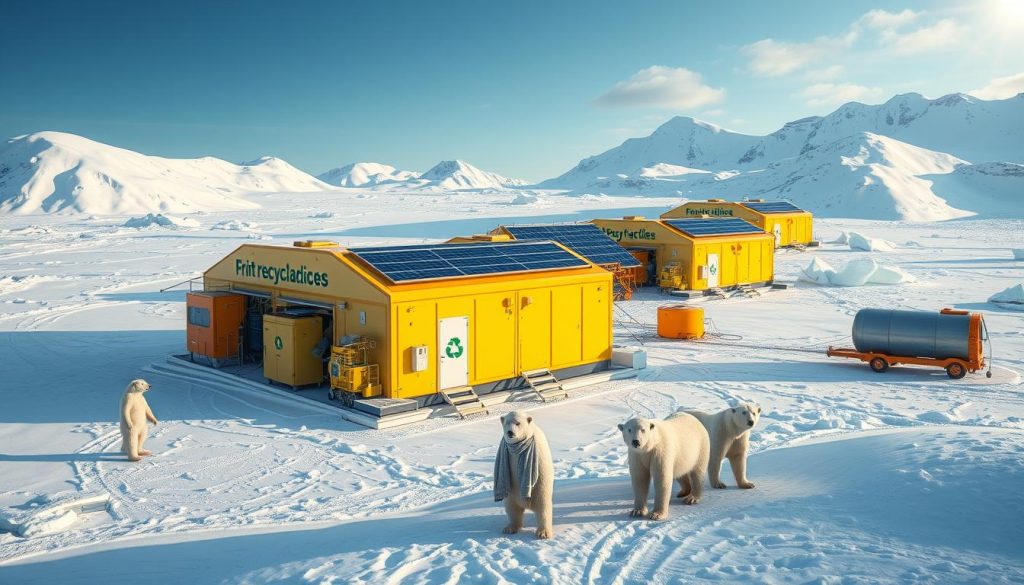
Innovative waste management is crucial in Antarctica’s unique setting. Advanced recycling and sustainable energy are key for managing waste efficiently. This offers opportunities for waste reduction and better resource use.
Utilising Advanced Recycling Technologies
Advanced recycling in polar areas improves waste management. Mobile units, featuring compactors and shredders, process waste effectively. They handle plastic, metal, and organic waste, even in extreme conditions. This helps Antarctic stations and expeditions manage their waste.
- Recycling technologies turn waste into reusable materials, easing the waste load.
- Partnering with companies in advanced recycling aids in research and development.
- Investing in these systems supports global sustainability, especially in remote areas like Antarctica.
Implementing Waste-to-Energy Systems
Waste-to-energy systems are a good solution for Antarctica’s waste issues. They lower waste and produce electricity and heat. Technologies like anaerobic digestion and gasification could work in extreme cold, offering sustainable energy for waste-to-energy projects.
- Waste-to-energy brings benefits of less waste and more energy.
- Trying pilot projects could show how these systems work in Antarctic conditions.
- Such projects promote cleaner energy in remote places.
Sustainable Practices for Harsh Environments
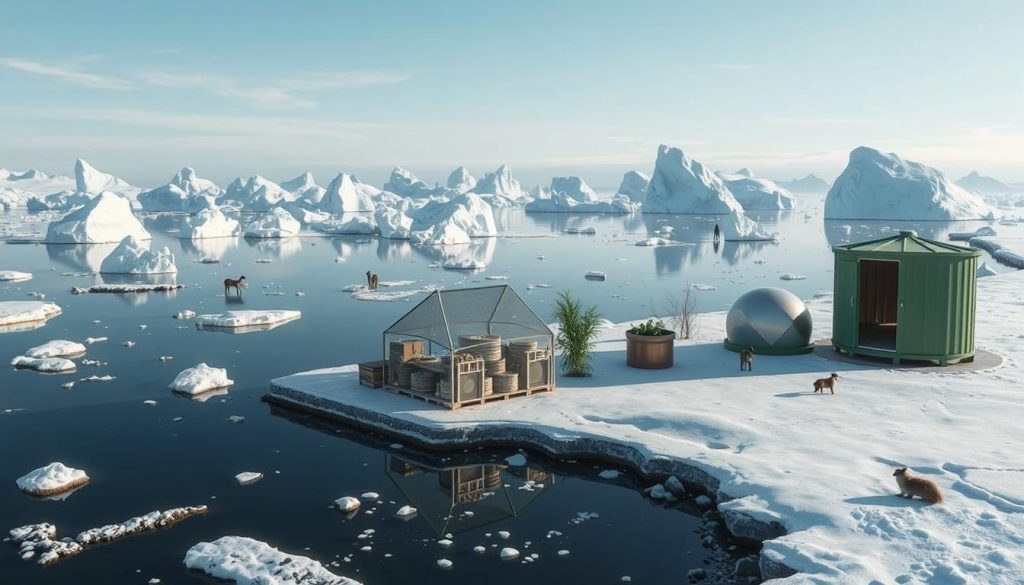
Implementing sustainable practices in places like Antarctica is key to protect its ecosystem. Using eco-friendly materials is crucial. This reduces waste and helps keep the polar environment safe. Shifting to biodegradable options shows we care about our planet. It also keeps the natural balance safe.
Eco-Friendly Materials and Alternatives
Using biodegradable packaging and compostable containers helps the Antarctic. These materials break down naturally, meaning less long-term waste. It also lessens the risk to wildlife. Studies show that some eco-friendly materials work well even in cold. They are good solutions for managing waste in these areas. Adopting these sustainable practices is important for future protection. It tackles current waste problems and helps achieve wider environmental goals.
The Role of Research Stations in Waste Management
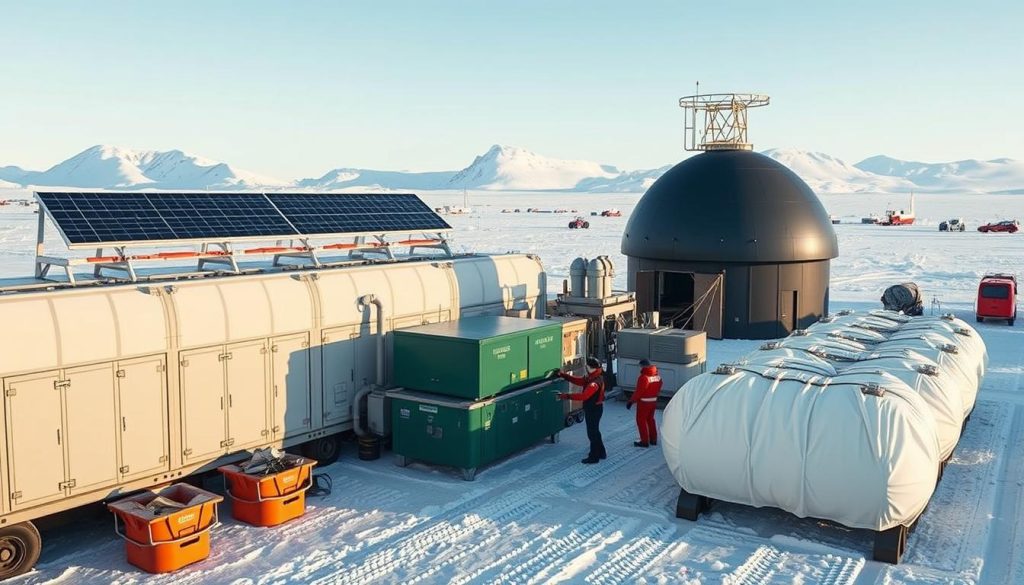
Research stations in Antarctica are crucial in dealing with waste. They produce waste but also find new ways to manage it. This includes waste management success stories. They use recycling and sustainable methods, leading in environmental care.
They work together on collaborative waste solutions. These efforts are great Antarctic examples for others to follow.
Case Studies of Successful Practices
The British Antarctic Survey shows how research stations reduce waste. They manage resources well. Here are some key actions they’ve taken:
- They cut down on packaging by buying wisely.
- They recycle on-site which lessens waste from transport.
- They train their team on how to reduce waste.
This shows the power of working together on collaborative waste solutions. Research stations’ dedication to being green is inspiring. They prove that good waste management success stories can come from the toughest places.
Innovative Collection Methods for Remote Areas
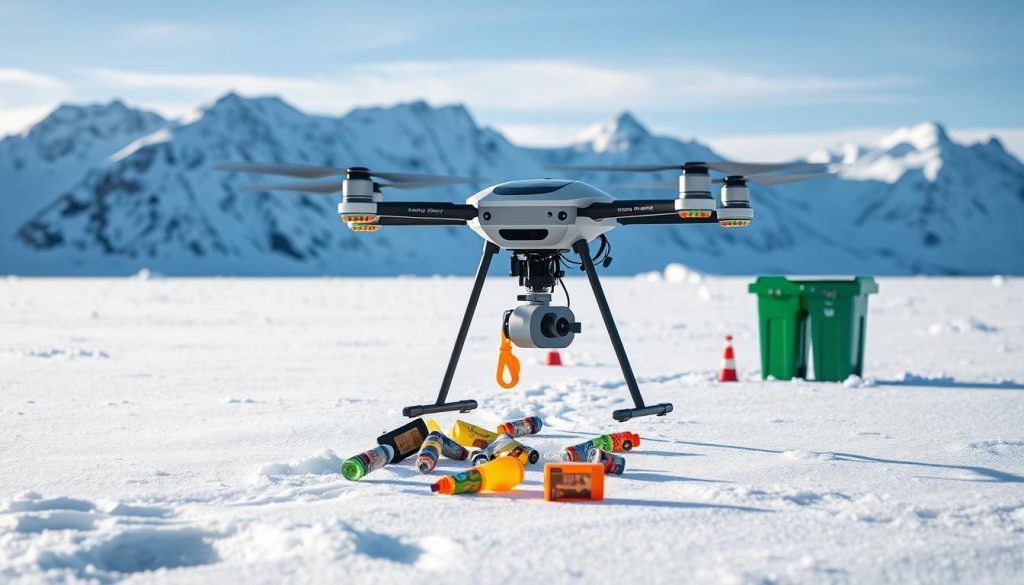
Managing waste in Antarctica is tough. It calls for creative ways to handle waste. We have drone-assisted waste collection and portable waste compactors. These methods make waste collection better and less harmful to the environment, especially in tough places.
Drone-Assisted Waste Collection Solutions
Drones are changing how we collect waste. They reach places that are hard to access, perfect for the challenges in Antarctica. Drones bring many benefits, like:
- Less effort needed from humans in difficult places.
- Better efficiency, leading to faster waste pick-up.
- A smaller carbon footprint than old ways of collecting waste.
Testing these drones could show us their value. It could prove how they change waste collection in isolated areas.
Portable Waste Compaction Technology
Portable compactors are great for reducing waste size in Antarctica. By making waste smaller, it’s easier to move and get rid of. These compactors are tough and work well in cold conditions. They have:
- Strength to deal with very cold weather.
- Small sizes so they can be moved easily.
- Good compression to save space.
Tests in the field show these compactors work well. They are very useful for people living and working there, showing they’re key in dealing with waste.
Partnerships with Local Communities and Organisations
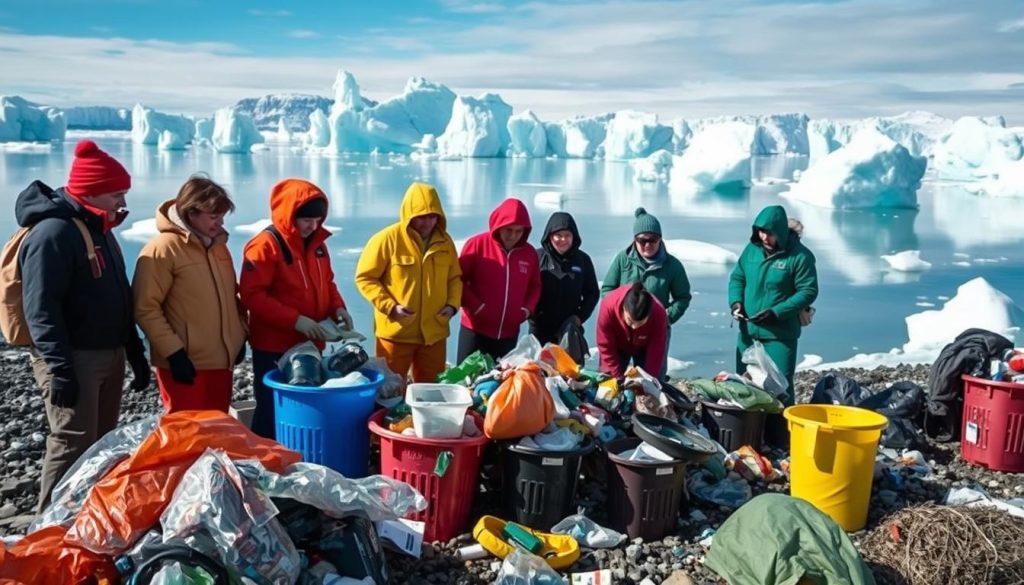
Creating strong local ties is key to managing waste well in Antarctica. Working with local people and groups brings out smart ideas that meet the area’s unique needs. These ties help involve the community, making sure waste plans consider what locals think and need.
In these efforts, Antarctic organisations are vital. They partner with local governments, NGOs, and research bases, sharing knowledge and resources. This teamwork improves how waste is handled and gets locals involved and committed.
Here are some successful examples of such teamwork:
- Joint recycling programs that get local volunteers on board
- Team campaigns to teach people how to reduce waste
- Projects that mix local traditions with new waste handling methods
Strong partnerships can make waste management better and more lasting. These actions address today’s waste problems and help keep Antarctica’s environment safe for the future.
The Importance of Education and Awareness
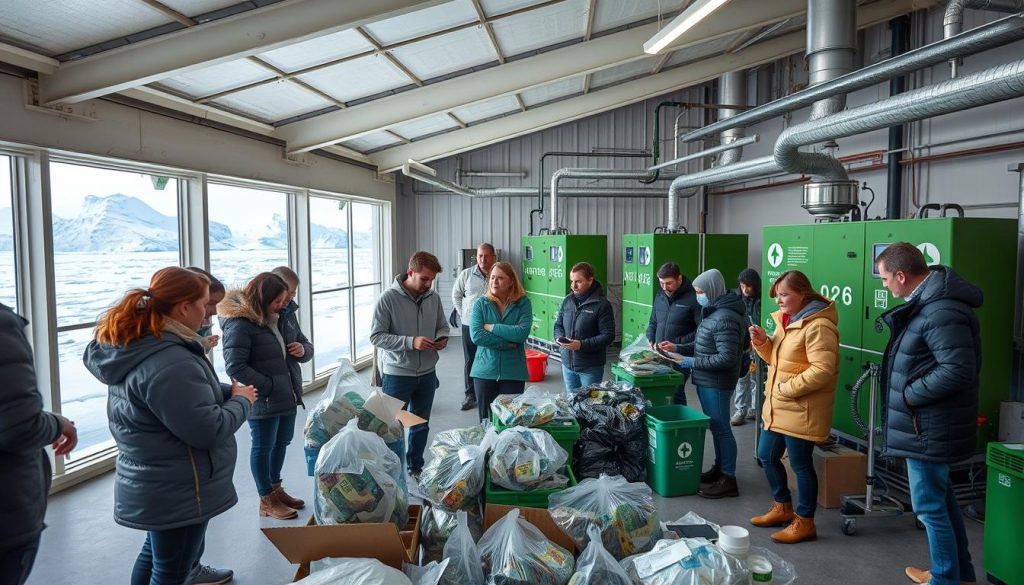
Education and awareness are key to better waste management in the Antarctic. This area faces unique challenges. Thus, there’s a need for special education programmes. These programmes teach staff how to manage waste well.
They help everyone understand the right practices, follow environmental rules, and reduce harm to the environment.
Training Programmes for Waste Management Personnel
Specific training for waste management staff is vital. It marries theory with practical know-how. So, staff learns how to deal with waste in Antarctica properly.
Several methods help staff master sustainable practices. These include:
- Workshops on cutting waste and recycling.
- Practical learning with waste management tools and technologies.
- Efforts to make everyone aware of the need to handle waste responsibly.
Educational bodies in Antarctica have started great training programs. These show that well-trained staff can hugely improve how waste is managed. This leads to better work and caring more for the environment.
Leveraging Technology for Efficient Waste Tracking
![]()
Technology is changing how we manage waste, making it easier and more efficient. By using IoT technology, we can now monitor waste in real time. This means we know what kind of waste we have and how much. It helps us collect it better and find smarter ways to deal with it.
Implementing IoT for Real-Time Waste Monitoring
IoT technology gives waste managers the data they need to make smart choices. Connected sensors let us watch waste as it builds up. Over time, we learn patterns that improve how we collect data and work more efficiently.
- Enhanced decisions: Real-time data helps avoid overfull bins by monitoring waste levels.
- Optimised collections: With IoT, scheduling pickups is smarter, making sure efforts are put where needed.
- Increased transparency: Everyone can see what’s happening with waste, which helps with being responsible.
Testing IoT in real-life situations shows how valuable it is for managing waste better. It opens up new ways for businesses to plan. As technology moves forward, our methods of handling waste can improve too.
Creating Circular Economy Models in Extreme Conditions
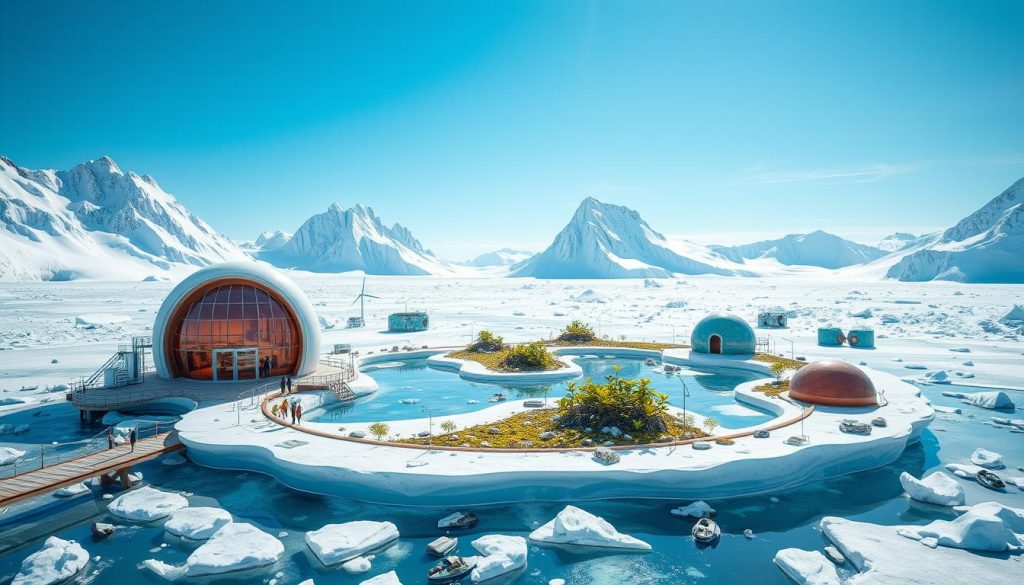
The idea of a circular economy is crucial in places like Antarctica. Here, the need to manage resources wisely and protect the environment is high. By developing strong reuse plans, waste becomes useful again. This helps build a sustainable economy, even in tough climates. Such methods reduce waste and strengthen the local ecosystems.
Opportunities for Upcycling and Reusing Materials
Upcycling offers a great way to support sustainability and circular economy goals. In Antarctica, upcycling could look like this:
- Turning old packaging into useful tools or parts of buildings.
- Giving new life to outdated equipment for research or exploration.
- Setting up systems to reuse materials from science projects.
These approaches help cut down on waste. They show how a self-supporting ecosystem can be achieved. By embracing circular economy methods, we can create a sustainable model in Antarctica. This protects the environment while supporting local needs.
Regulatory and Environmental Considerations
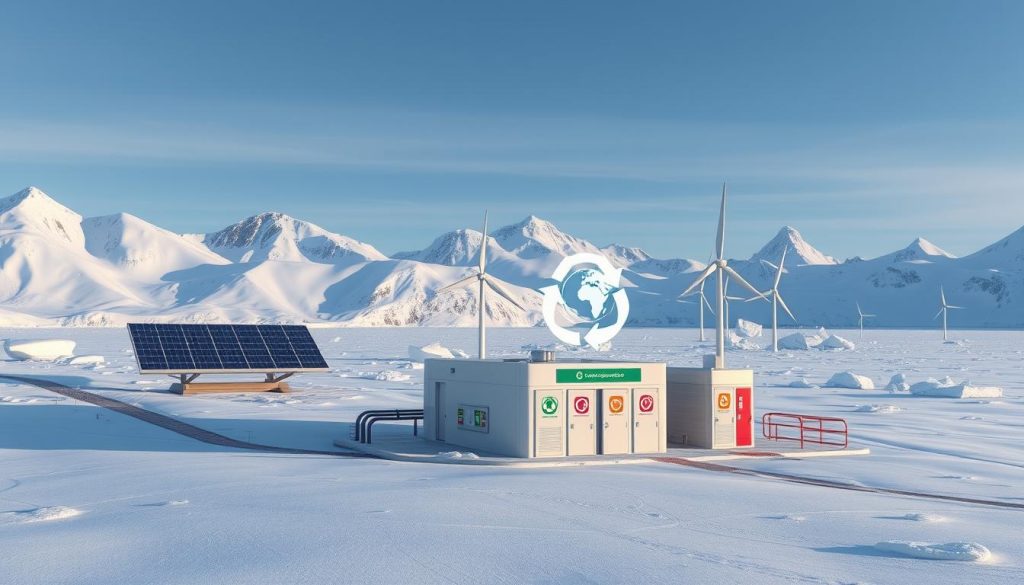
Waste management in Antarctica follows a set of complex rules and international treaties. Knowing these rules is crucial for any group trying to manage waste there properly. The Antarctic Treaty System plays a key role in this. It makes sure all actions there are sustainable and meet certain standards.
Understanding International Treaties and Agreements
The Antarctic treaties lay out strict environmental rules. Companies dealing with waste must make sure they follow these rules to protect the environment. They must avoid actions like mining and dumping waste that could harm nature. They also need to focus on recycling and disposing of waste sustainably.
Knowing these treaties helps businesses stay in line with the law. This way, they can succeed in a place with many regulations. Setting up strong plans that follow these legal guidelines is vital. It’s the base for sustainable work in Antarctica.
Potential for Mobile Waste Management Units
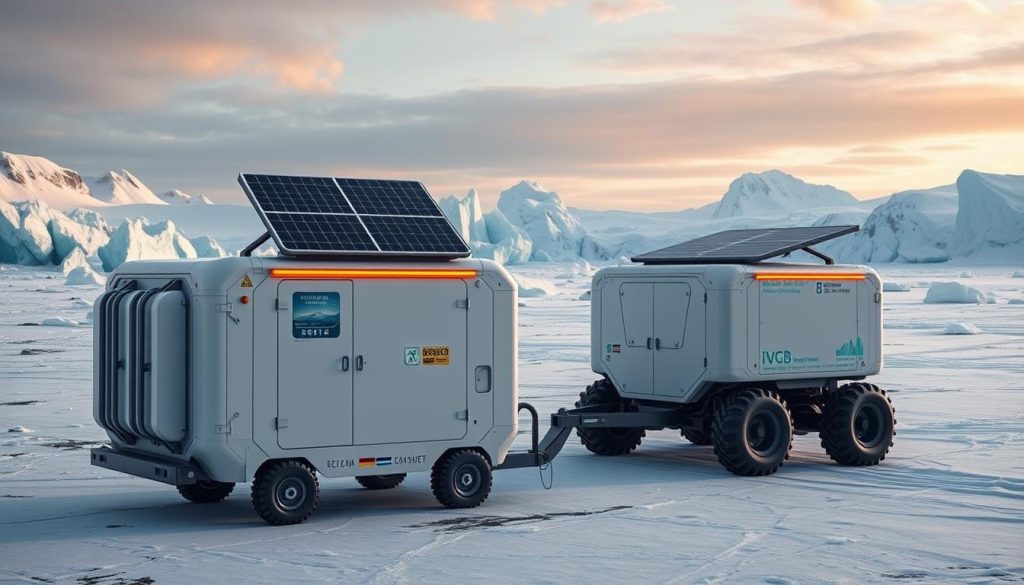
Mobile waste management units offer a great solution to the special waste disposal problems in Antarctica. These units can be custom-made to fit strict standards. This ensures they work well in the harsh conditions found there. By adopting flexible waste management methods, these mobile units help in managing waste efficiently during operations in the polar areas.
Design Considerations for Mobile Units
Several key design features are important for these mobile waste units to function well:
- Insulation: Good insulation is vital to withstand the extreme cold. It stops damage and keeps the inside conditions right for processing waste.
- Robust Materials: Using strong materials helps the units last longer against the harsh weather and rough ground of polar regions.
- Energy Efficiency: Including sources of renewable energy makes the units more sustainable. This way, they don’t depend much on traditional fuels to run.
- Modular Design: A design that can be easily changed or expanded is useful. It allows the units to handle different amounts and types of waste in various operations.
By paying attention to these design factors, mobile waste management units can be very useful in Antarctica. They improve how waste is dealt with in some of the toughest places on Earth.
Investment Opportunities in Antarctic Waste Management

The Antarctic region offers exciting opportunities for waste management investment. The focus on sustainability is very high now. There’s a need for waste management solutions that work well in cold, harsh places. Investors have a chance to fund sustainable projects designed for the Antarctic.
Some great areas for investment are:
- Research into new technologies for managing waste.
- Building recycling centres that can handle extreme weather.
- Forming partnerships with organisations that want to protect the Antarctic.
There’s a rising interest from investors in the Antarctic. They want to support projects that help the environment. Investing in eco-friendly waste disposal or waste-to-energy could be profitable and good for the planet.
Seeking out grants and working with public and private partners can make these projects possible. Collaborating with research groups offers support and helps validate new ideas in this special area.
Environmental Impact Assessment for New Ventures

It’s key to do effective environmental impact assessments (EIAs) for new waste management projects in Antarctica. These checks are critical in understanding the effects on the region’s fragile ecosystems. They require thorough evaluation methods.
Assessments help see the ecological impact of new projects. Doing these early on helps in making wise choices. This supports responsible business growth.
Evaluating Ecological Footprints
Understanding ecological footprints is a major part of environmental assessments. This process looks at how new activities might harm local wildlife, habitats, and the overall environmental balance. It’s vital for new projects to think about:
- The types of materials used in operations
- The emissions produced through logistics and waste management
- The effects on local flora and fauna
- Long-term consequences for climate change
Rigorous assessments ensure businesses follow environmental laws and promote sustainability. Each factor is crucial to keep the environment balanced while also allowing for innovation in Antarctica’s tough conditions.
Future Trends in Waste Management for Polar Regions

The future of waste management in polar regions is set to change. With increasing challenges, new tech and solutions bring hope for sustainability. Researchers and companies are looking at ways to cut down waste impact and improve recycling.
Emerging Technologies and Innovations
New technology is key to changing waste management in cold areas. For example, better waste sorting makes it easier to recycle. Using nature’s ideas, we can create waste systems that are good for the planet.
- Integration of artificial intelligence into waste management systems facilitates real-time tracking and analysis.
- Advanced drones for waste monitoring and collection enhance operational efficiency in difficult terrains.
- Innovative microbial treatments can breakdown organic waste more efficiently, contributing to cleaner environments.
These new technologies show a big move towards smart, data-driven waste management. By using these innovations, people can tackle the challenges of polar regions effectively.
Building Resilience against Climate Change
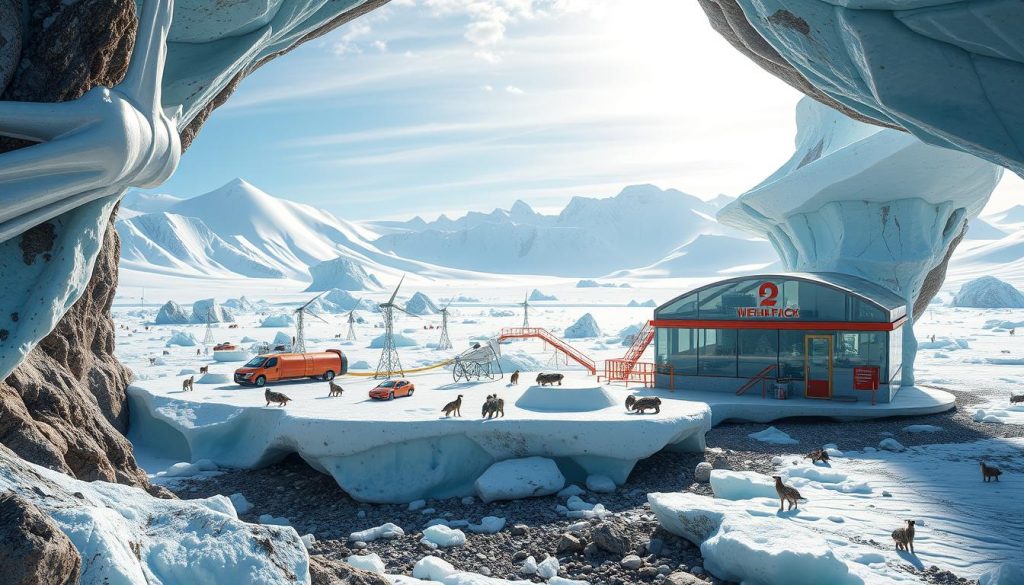
Managing waste well is key in fighting climate change, especially in places like Antarctica. The warming world brings unique challenges that need smart solutions. Setting up strong waste systems helps solve disposal problems and supports lasting growth.
Being adaptive means using new tech and ideas that react well to climate change. These include:
- Recycling to use less new materials and cut down on carbon emissions.
- Composting to make soil better and lower harmful methane gas.
- Using circular economy ideas to keep reusing resources.
Focusing on how we manage resources helps ensure our actions don’t harm the planet. We need to be sustainable to lessen damage and become more climate tough. These steps are key in making sure waste management helps our climate fight.
Case Studies of Successful Waste Management Start-ups

Exploring real-life examples helps us understand the journey of successful waste management start-ups. These case studies show creative ways to handle waste, the challenges faced, and valuable lessons for the future. In particular, they show how to overcome the tough conditions in places like Antarctica. By looking at the best methods used, new companies can find ways to succeed in their own situations.
Learning from Industry Leaders
Some waste management companies have really made a difference by tackling problems and boosting sustainability. They’ve shown that seeing challenges as chances to innovate can lead to breakthroughs. From their stories, we learn key points:
- Engaging with people involved is important for gaining community backing.
- Customising technology to meet local needs makes things run smoother.
- Being creative keeps companies ahead as markets change.
Studying these stories highlights the importance of sustainable actions to push the industry forward. For example, some start-ups have built systems that recycle stuff right where they are. This cuts down on pollution from transport and saves money. These lessons are not just for the big players but also guide newcomers striving to make a mark in waste management.
The Economic Viability of Waste Management Solutions
To figure out if waste management in Antarctica is a good idea money-wise, a detailed analysis is needed. This means looking at the costs and benefits of using sustainable methods in one of the toughest places on Earth. We aim to find cost-effective ways that are good for both the environment and the economy.
The key to getting investment is showing how waste management leads to savings or profits. Studies from Antarctica show that being eco-friendly can save a lot of money in the long run. By using the latest in recycling and waste-to-energy, we can cut costs and make waste handling better.
Also, bringing in new methods like mobile waste units and working with research bases can show how cost-effective these ideas are. Highlighting these financial upsides makes it easier to support waste management projects. This helps keep Antarctica clean for the years to come and opens opportunities for green businesses.

